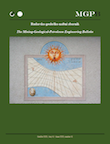Middle Miocene drowned ramp in the vicinity of Marija Bistrica (Northern Croatia)
DOI:
https://doi.org/10.17794/rgn.2018.4.3Keywords:
Langhian, transgression, palaeoenvironment, biostratigraphy, Medvednica Mt.Abstract
Fossiliferous Middle Miocene deposits from the surroundings of Marija Bistrica (north-east of Zagreb) transgressively overly older pre-Cenozoic bedrocks. Fossils from shallow marine environments are in most cases preserved as bioclasts, while deep marine calcareous oozes characterize the pelagic marls. The age of the transgressive sequence is estimated on the basis of planktic biota from marls (foraminifera, nannoplankton and pteropods) as the Badenian NN5 Nannozone. The following palaeoenvironments can be distinguished or presumed on the basis of biota and sedimentary features: (1) beach characterized by polymictic conglomerates with rhodolith-rich carbonate matrix; (2) oyster banks, recognized from secondarily found oyster clusters; (3) lagoons marked with compact bioclastic deposits and rhodolith-halimeda assemblage; (4) patch-reefs recognized from the surrounding bioclastic deposits; (5) shallow subtidal mäerl beds preserved as loose bioclastic deposits and (6) distal slope argillaceous marls with pelagic biota. Palaeoenvironmental analyses indicate rapid drowning, most probably corresponding to the transgression during the Middle Badenian TB 2.4 3rd order transgressive-regressive sequence.
Downloads
Published
Issue
Section
License
Copyright (c) 2018 Rudarsko-geološko-naftni zbornik

This work is licensed under a Creative Commons Attribution 4.0 International License.
Creative Commons-BY
Authors who publish with this journal agree to the following terms:
In agreeing this form, you certify that:
- You read the ethical codex of the RGN zbornik available at journal web.
- You submitted work is your original work, and has not previously been published and does not include any form of plagiarism.
- You own copyright in the submitted work, and are therefore permitted to assign the licence to publish to RGN zbornik.
- Your submitted work contains no violation of any existing copyright or other third party right or any material of an obscene, libellous or otherwise unlawful nature.
- You have obtained permission for and acknowledged the source of any illustrations, diagrams or other material included in the work of which you are not the copyright owner.
- You have taken due care to ensure the accuracy of the work, and that, to the best of your knowledge, there are no false statements made within it.
- All co-authors of this submitted work are aware of, and in agreement with, the terms of this licence and that the submitted manuscript has been approved by these authors.
Publication licence
You retain copyright in your submitted work, according to journal license policy (CC-BY). By signing this form you agree that RGN zbornik may publish it under the publication licence. In summary the licence allows the following:
Anyone is free:
- To copy, distribute, display, and perform the work.
- To make derivative works.
Under the following conditions:
- The original author must always be given credit.
- The work may not be used for commercial purposes.
- If the work is altered, transformed, or built upon, the resulting work may only be distributed under a licence identical to this one.
Exceptions to the licence
In addition to publishing the work printed under the above licence, RGN zbornik will also enable the work to be visible online.
The journal editorial can change the licence rules anytime but it cannot retroactively restrict author(s) rights.


